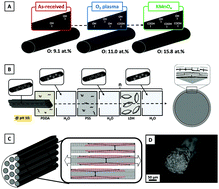Increasing carbon fiber composite strength with a nanostructured “brick-and-mortar” interphase†
Abstract
Conventional fiber-reinforced composites suffer from the formation of critical clusters of correlated fiber breaks, leading to sudden composite failure under tension. To mitigate this problem, an optimized “brick-and-mortar” nanostructured interphase was developed, in order to absorb energy at fiber breaks and alleviate local stress concentrations whilst maintaining effective load transfer. The coating was designed to exploit crack bifurcation and platelet interlocking mechanisms known in natural nacre. However, the architecture was scaled down by an order of magnitude to allow a highly ordered conformal coating to be deposited around conventional structural carbon fibers, whilst retaining the characteristic phase proportions and aspect ratios of the natural system. Drawing on this bioinspiration, a Layer-by-Layer assembly method was used to coat multiple fibers simultaneously, providing an efficient and potentially scalable route for production. Single fiber pull-out and fragmentation tests showed improved interfacial characteristics for energy absorption and plasticity. Impregnated fiber tow model composites demonstrated increases in absolute tensile strength (+15%) and strain-to-failure (+30%), as compared to composites containing conventionally sized fibers.

- This article is part of the themed collection: International Year of the Periodic Table : Low Dimensional Carbon Systems


 Please wait while we load your content...
Please wait while we load your content...